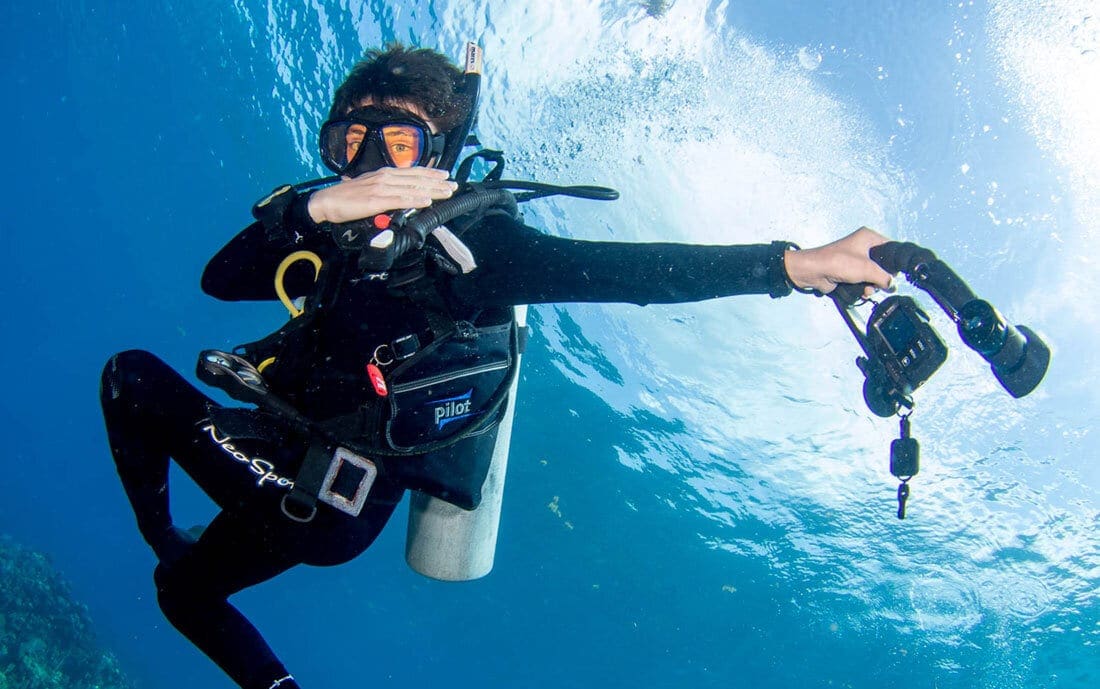Photographers best practices
By Josh Comay and Margo Peyton: (Professional Dive Travel Photographers)
After years of speaking to frustrated guests, photographers, and divers. I felt compelled to put helpful etiquette tips together for photographers. I have been diving for 30 years, and I asked my fellow photographer, Josh Comay, to assist me and share his tips as well. I will share this with families that travel with Kids Sea Camp and Family Dive Adventures going forward and I hope you will share it too. If you have some good advice to add, please let me know and I will add to this best practices list.
Josh and I are very conscious and courteous photographers, and we are very aware that on my dive trips we are serving guests. So we stay out of the way, stay patient and try our best to make lasting memories of everyone’s dive trip to give them all free of charge memory to last a lifetime. Many of these points are great points for diving in general. So please read, enjoy and when you feel the need, pass it forward.

Best practices for photographers
- Do not touch/harass/move any wildlife: This is always at the top of an etiquette list for good reason. I can’t tell you how many times I’ve seen people “escort” wildlife into a better position for their photo ops. (Josh)
- Diving with other photographers: when a photographer finds something interesting, they should take their shots, without chasing off the subject or doing it any harm. A pro should take only 3 shots or less using flash or strobe! (NO more than 3 shots with lights) If you want to know why, then put your face in front of your camera with lights and shoot away. See how long it takes you to be able to see again! If you can use natural light then do so. Shooting upwards instead of down is helpful along with making sure the natural light source is at your back and on your subject. Without lights, shoot away, but remember to share your subject with others. (Margo)
- Master your buoyancy: Be sure to spend at least some of your underwater time practicing perfect buoyancy without a camera – it will do wonders for when you are armed. (Josh)
- Watch your fins: Your buoyancy should not only be maintained while taking your photos but awareness of where your fins are when you leave. Don’t be that person to destroy the subject along with its environment or kick the next diver on your way out. Look around before you move and move cautiously. Do not shove another photographer out of the way, or intrude on their shot. Move on to something else if they are not sharing, and send them this if it continues. (Margo)
- Give people space. Don’t crowd other divers whether they are shooters or not. If you need to wait your turn, do it down current so you don’t introduce particulate into the frame. (Josh)
- Big animals: If you are on a big animal dive and everyone is being positioned so that each person can have a view and a shot, stay in your position. When the lead says stay put, then stay put. If something big shows up towards the end of the dive, remember everyone has the same time remaining as you do. Be courteous to each other and remember these points. (Margo)
- Drop the flutter: Flutter kick near sand and muck can ruin the scene for everyone. Learning and using the frog kick is essential so you don’t silt out other divers and their shots. (Josh)
- Where are your weights? Placement of weights is also very helpful if you have a bigger rig that pulls you forward, places weights in the back of your BC. Or even use ankle weights or camera floats. Remember you still have to be neutrally buoyant if for some reason you need to put your camera down or hand it off. Your camera should not be your weight. (Margo)
- Pay it forward. Let the next diver in line know what you were shooting and wait for his or her positive identification. There’s nothing more annoying than waiting your turn only to have the previous diver swim off without showing you where the Pygmy is hiding. (Josh)
- Remember space on the boat is precious. Don’t leave camera equipment strewn all over the place. If you are lucky enough to have an area designated for cameras on board, tuck your strobes and arms in compactly and store equipment with concern for other shooters’ rigs. (Josh)
- Share the shot. Settle in and take a number of shots but be respectful that others may also be waiting. If you arrive just ahead of non-shooters, consider showing them the subject first after which they will likely swim off and you can take your time shooting. (Josh)
- Set expectations. Some people like to limit a dive to just 2 or 3 subjects. Some people like quickly shooting a shot or two of every possible species they encounter. Consider having an open conversation with the other shooters aboard to discuss your style and expectations. Everyone may not always agree, but if you don’t bring it up, you’ll never know. (Josh)
- Macro or wide angle? Discuss with the boat crew the next days dive sites or even early that morning. There is nothing like showing up with your 60mm macro lens only to find out your diving with whale sharks today. (Margo)
- Mind your bubbles too. It’s frustrating to say the least to be at 40 ft for example, working on a shot, only to have a diver go under you and ruin the shot with their bubbles. (Margo)
- Don’t forget your buddy. Having a camera does not exempt you from being a good buddy. Even in the most intense shooting, be sure to keep close tabs on your buddy just as you would do normally. (Josh)
- Work as a team: Its best for Buddy teams to have one shooter and one spotter. This is ideal as one can keep an eye on the other. I have witnessed a buddy photographer that does not pay attention to gauges and forgets to look at air, depth and time. Running out of air is not OK. Going into DECO is not ok. Be a good buddy and pay attention. (Margo)
- Manage your depth, time and profiles. Plan your dive and dive your plan! The deepest part of your dive is at the start and you should continue shallower as the dive goes on. Not up and down or the other way around. (Margo)
- Respect all fellow divers. Camera carrying divers don’t have special privileges nor do non-shooting divers. Similarly, whether shooting a simple point-and-click or the latest ultra DSLR rig, everyone should be afforded the same opportunities to the amazing underwater world. (Josh)
- On the boat, before you leave. Make sure the crew has a solo rinse bucket for cameras only, with no soaps. Make sure that its announced to all divers and the camera bin pointed out. Ask if the camera bucket is salt or fresh water. It should be fresh water. If it’s a crowded photo dive, rinse your camera and then remove it from the bin and put it on the camera table or request a crate for larger rigs. You should never throw, drop or toss a camera in the camera bucket and certainly do not place it on top of someone else’s! Those that have a small point and shoots with rubberized housings like Sealife cameras they are more rugged but can easily damage a large fragile rig. Be courteous to the more fragile setups. If you have a larger setup, then don’t hog the camera bin. Fold your lights, and take a smaller space, or put your rig on the table or request a crate. Don’t clutter camera tables with anything but cameras. That’s what it is for. (Margo)
- Getting on and off the boats. Get your self-ready, point out your camera to the dive helper on the table or in the bin and get in the water. Allow them to hand down the camera to the photographer before others start jumping in. When exiting hand up your rig and then get out. People behind a photographer should be patient and wait for the camera handoff either way.
- Let the crew know your plan. Make sure you discuss with them if you’re going deeper, staying longer, or if you’re staying deep or shallow. (Margo)
- Everyone has a right to enjoy the dive, When shooting divers, shoot them as an observer like you would a fish. Do not continue asking him or her to constantly pose. Don’t interrupt a class to take photos. A safety stop is a great time to get a pose or two. Discuss with the other divers prior to entering the water that you would like to take their picture and ask if it’s ok. (Margo)
- Many divers just don’t know any better and are completely unaware. It’s important to advise divers your traveling with, what is considered courteous. (Margo)
- Say what you mean, but don’t say it mean. If you experience someone that is ruining your dives, and you or others have nicely said something and issues still continue, talk to the crew or the captain. It is their job to create a harmonious dive for all. (Margo)
- Get your own boat. If you like to hog the marine life and shots if you do not want to share and feel its all about you. Then charter your own private boat and crew. (Margo)
- Help others to be better, Divers and photographers. We did not get to be without someone coaching us. (Margo)
- Bubbles only: Take only pictures leave only bubbles. (Margo)
